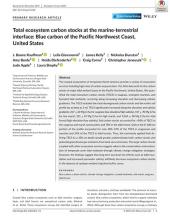
Abstract
The coastal ecosystems of temperate North America provide a variety of ecosystem services including high rates of carbon sequestration. Yet, little data exist for the carbon stocks of major tidal wetland types in the Pacific Northwest, United States. We quantified the total ecosystem carbon stocks (TECS) in seagrass, emergent marshes, and forested tidal wetlands, occurring along increasing elevation and decreasing salinity gradients. The TECS included the total aboveground carbon stocks and the entire soil profile (to as deep as 3 m). TECS significantly increased along the elevation and salinity gradients: 217 ± 60 Mg C/ha for seagrass (low elevation/high salinity), 417 ± 70 Mg C/ha for low marsh, 551 ± 47 Mg C/ha for high marsh, and 1,064 ± 38 Mg C/ha for tidal forest (high elevation/low salinity). Soil carbon stocks accounted for >98% of TECS in the seagrass and marsh communities and 78% in the tidal forest. Soils in the 0-100 cm portion of the profile accounted for only 48%-53% of the TECS in seagrasses and marshes and 34% of the TECS in tidal forests. Thus, the commonly applied limit de-fining TECS to a 100 cm depth would greatly underestimate both carbon stocks and potential greenhouse gas emissions from land-use conversion. The large carbon stocks coupled with other ecosystem services suggest value in the conservation and restoration of temperate zone tidal wetlands through climate change mitigation strategies. However, the findings suggest that long-term sea-level rise effects such as tidal inundation and increased porewater salinity will likely decrease ecosystem carbon stocks in the absence of upslope wetland migration buffer zones.
About this article
This article, which appeared in Global Change Biology in 2020, discusses findings from a study that quantified total ecosystem carbon stocks of major tidal wetland types in the Pacific Northwest. The research team collected carbon sequestration cores and other carbon stocks and ecosystem driver data from 34 sites representing the full range of Pacific Northwest tidal wetland classes (seagrass, low marsh, high marsh, and forested tidal wetlands) and geographically distinct coastal regions (Salish Sea/Puget Sound, Columbia estuary, and outer coast estuaries from Washington to northern California). This study was part of a regional data collection and database development effort to support the incorporation of blue carbon science into coastal management and climate change mitigation and adaptation.
Kauffman, J.B., L. Giovanonni, J. Kelly, N. Dunstan, A. Borde, H. Diefenderfer, C. Cornu, C. Janousek, J. Apple, and L. Brophy (2020). Total ecosystem carbon stocks at the marine-terrestrial interface: Blue carbon of the Pacific Northwest Coast, United States. Global Change Biology. DOI: 10.1111/gcb.15248